The Traveler’s Bottled Water Dilemma

Plastic bottles are a scourge in many parts of the world, particularly in developing countries – the same countries where tap water is often not safe to drink for Western travelers. Developing countries often have limited recycling facilities as well, and empty plastic water bottles wind up in massive landfills. In many places, the majority of the bottles in the landfill come from tourists. Yet tap water is often contaminated with disease-causing parasites, fecal bacteria, and other sorts of nastiness that would ruin your trip in a big way.
This conundrum presents a dilemma: do you buy bottled water and help make the planet sick, or drink the tap and risk getting sick yourself?
First of all, you should try to avoid buying and drinking bottled water as much as possible:
No matter where you are traveling, carry a refillable plastic water bottle. Get yourself a long-lasting water bottle (such as Nalgene brand) that is BPA-free. Even if you only fill it up once for your outbound flight from the airport’s water fountain, that’s one less plastic bottle that you bought and threw away.
Use every opportunity available to refill your bottle with clean water. Many hotels and hostels that cater to Western travelers provide a large dispenser of purified drinking water. Take advantage of the clean water, and fill up your container before you go to bed, after you wake up, and before you leave the hotel. Think ahead so you aren’t stuck in a bus or on a beach with no water – and are forced to buy a plastic bottle.
Carry iodine tabs or another water purification system, like a Lifestraw. Especially if you are hiking or camping, iodine tabs or the equivalent can turn questionable water from rivers and streams into a drinkable source. Hate the taste of iodine? Consider a personal filtration system instead. Lifestraws and other water filters converted contaminated water into clean, safe drinking water.
Boiling water can also purify it from many contaminants, however be aware that you must boil it for at least three minutes – or longer at high altitudes. If you didn’t boil it yourself, double check with the person who did.
Drink sparkling water instead. Carbonated water is often packaged in glass bottles that will be reused again and again. Since its processed and bottled, it’s generally safe to drink. Unlike soft drinks, carbonated water contains no sugar or artificial flavors and dyes. It’s just water, with bubbles.
Sometimes however, you might not have access to clean water, purification tabs, or a stove for boiling. Gastroenteritis is a great way to ruin your trip. If you find yourself in this situation, and you have to buy bottled water:
Buy larger bottles of water to refill your smaller bottle. Carry a gallon-size bottle back to your hotel room, and then fill up the bottle you brought from home for your daily adventures.
Leave empty plastic bottles at your place of lodging, instead of tossing them into a public trashcan. Many hotels and hostels are initiating recycling programs, and provide some of the only recycling in the area. Plastic bottles in garbage cans will most likely end up in a landfill.
Ask your hotel if they have a recycling program for plastics and other materials. Even if they don’t, if enough travelers request this service, it will encourage the hotel to institute a recycling program.
When you get home, plant a tree or two. And brainstorm other ways you can reduce your plastic usage to balance out your bottled water karma.
Related on Organic Authority
Coca-Cola’s ‘Sustainable’ PlantBottle Claims Full of Hot Air
Bottled Water Industry Compares Ban on Plastic Bottles to Racism
Have We Hit Peak Plastic Bottle? College Bans Spill Across the Country
Image: dchou0123

